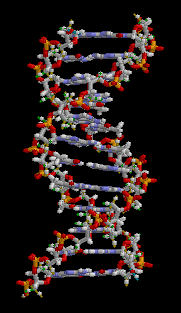 My latest issue of New Scientist has an interesting article about the discovery of four-stranded DNA in cancer cells. “Normal” DNA is a double helix, like a twisted ladder in which two sides are connected by rungs (see animation at right). However, DNA structures with different numbers of strands, three and four, have been studied, as well. The article mentions that three-stranded DNA is thought by some to be involved with disorders such as Huntington’s disease and Friedreich’s ataxia. Quadruple helices, using four strands of DNA, had been created in laboratory settings, but they have now been found in cancer cells and are thought to be related to problems in cell division. The hope is that they are present in unique quantities in cancer cells such that they can be used to specifically target the cells for treatment.
My latest issue of New Scientist has an interesting article about the discovery of four-stranded DNA in cancer cells. “Normal” DNA is a double helix, like a twisted ladder in which two sides are connected by rungs (see animation at right). However, DNA structures with different numbers of strands, three and four, have been studied, as well. The article mentions that three-stranded DNA is thought by some to be involved with disorders such as Huntington’s disease and Friedreich’s ataxia. Quadruple helices, using four strands of DNA, had been created in laboratory settings, but they have now been found in cancer cells and are thought to be related to problems in cell division. The hope is that they are present in unique quantities in cancer cells such that they can be used to specifically target the cells for treatment.
One of the ideas is that the quadruple helix might be an element in the process embryo development which is somehow reactivated in cancer cells. The possibility is mentioned at the end of the article, where Dr. Shankar Balasubramanian says, “We need to find out whether the quadruplexes are a natural nuisance or there by design.”
Ahhhh, “there by design.” Just one of the many, many, many examples of design language that slips so naturally into discussions about biological function. In spite of themselves, authors of works on the nature and functioning of life systems always tend to invoke such “intelligence-involving” words: design, engineered, purpose,… I would not take it to mean that they are all secret believers in intelligent design, which would be false, nor do I believe that such words cannot be used in a metaphorical sense. After all, when I say that “circumstances conspired against him,” I don’t necessarily mean that circumstances, literally, were conspiring against someone, nor am I trying to imply that God, Himself, was actively doing so through those circumstances. (Though I would not say that the circumstances happened apart from His allowance, though that;s a different discussion for a different time!)
However, it is really telling, I believe, that such language remains the most natural for us to use in trying to make certain distinctions in biology. It reminds me of the comment made by Francis Crick–coincidentally, the co-discoverer of the double helix structure of DNA–in his memoir What Mad Pursuit (p.138): “Biologists must constantly keep in mind that what they see was not designed, but rather evolved.” In other words, they must firmly tell themselves to ignore the most natural conclusion one would draw, and, due to the overwhelming nature of the evidence, they must do so “constantly.”

So much for atheism being the “default position” of human thought as certain neo-atheists are claiming.
Pingback: That pesky word “design” « The Chronicles of Johanan Rakkav
Well said, and yes as a wildlife photographer, i marvel at folk’s statements, on evolution, vs the fact that our creator gave us all of it, and then some!! So, it’s a personal choice of faith, for me there’s no doubt…, and should i be wrong, then no harm, no foul, however if i’m right,,, it’s going to be the worse nightmare for eternity!
I’ve lost count on how many scientists have had to backtrack on comments that appear to be saying that this or that was “planned”, “constructed” or even … “created”! The words “willingly are ignorant” always come to mind.
Thanks for the article.